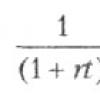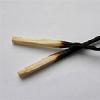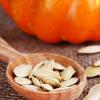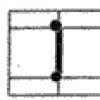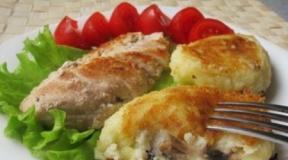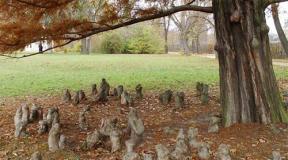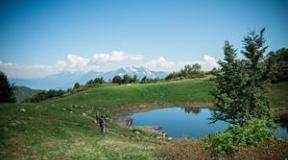Usda zone six. Climatic zones. Local conditions affecting winter hardiness of plants
What are USDA Hardiness Zones? What are the temperature ranges of frost resistance zones? What zone is Moscow located in? In which frost resistance zones is Russia located? – you will find answers to questions in the article.
Knowledge of frost resistance zones is often necessary when purchasing a previously unknown plant or some new variety supplied to the market from other countries. This data foreign manufacturers always indicated on labels or other accompanying documents, thus recommending the temperature limits within which the plant can be grown. The division into climatic zones in our country was carried out taking into account many other factors, therefore it is more complex and not widespread. The USDA hardiness zone temperature scale is the most popular in the world.
Frost resistance zones are climatic regions that are determined on the basis of the average temperature value of minimum temperatures. When delimiting areas of frost resistance, synoptic data for many years is used. This vertical temperature scale is used in agriculture, horticulture, landscape design- in a word, wherever there is a change of seasons or seasonal changes in environmental conditions.
First developed in the USA by the Department Agriculture(USDA - US Department of Agriculture) over time, the table has been improved and expanded. Currently, it contains 13 temperature zones, each of which has 2 subzones. Zero (in the original version) or first zone is the area with the lowest temperatures, corresponding to the Arctic region. And 11-12-13 zones are for tropical areas.
Despite some differences in the tables used in different countries, and the subjectivity of this assessment, they are used to determine the optimal conditions for plant growth. The most popular scale of climate zones, or hardiness zones, used in gardening guides is the USDA zone table. In 2012, the USDA hardiness zone map was updated. It presented higher minimum temperatures obtained from observations over the past 30 years, which simultaneously confirms the overall warming of the climate.
USDA zones and temperature values of frost resistance zones are given in the table in degrees Celsius
However, when choosing plants, it is necessary to take into account not only climatic regions and frost resistance zones, but also other features that create a microclimate, for example, proximity to water bodies, altitude, local topography, protection from winds.
Factors and reasons affecting frost resistance zones
Not only geographic latitude, but also dozens of other factors influence the minimum winter temperatures:
proximity to the ocean;
terrain;
the presence of cold or warm ocean currents;
protection from winds;
presence of hot underground springs;
plant biocenoses.
For example, in eastern Europe the climate is continental, with dry air and harsh winters. At the same time, Western Europe, being closer to the Atlantic Ocean with the warm Gulf Stream, has a humid climate with mild winters. Because of this, at the same latitude there are several frost resistance zones: from 5-6 in Eastern Europe up to 7-8 in the western part of the Eurasian continent.
Frost resistance zones in Russia range from zones 1 to 8. The largest part of Russia's territory falls into zones 2-5. This applies to both the European and Asian parts of the country. But if Central Siberia is 1-2 zones, Southern Siberia is 2, then as we approach the Pacific Ocean the same situation is observed as in Western Europe. Far East- zones 3 and 4, and coastal areas, Sakhalin and some islands - zones 5 or 6.
Not only frost resistance zones and local microclimate, created, for example, by the proximity of reservoirs and topography, affect the life of the plant being grown. The microclimate can be affected big cities. In megacities, houses create an artificial barrier that prevents winds. And the availability heating systems and electricity raise the average temperature by winter period by 5-8 degrees. An example is the territory of Moscow and its surrounding areas: they belong to zone 5. At the same time, the territory of the rest of the region is a clearly defined zone 4.
The depth of snow cover in winter can also be a determining factor when selecting plants. With good annual cover in zone 4, it is possible to grow plants in zones 5-6.
Below is a map of Russia and the average January temperature based on observations from 1961 to 1990. It can be assumed that the frost resistance zones (minimum temperature) of Russia will be located geographically within the same boundaries. Where purple is zone 1 (Verkhoyansk, Yakutsk), cornflower blue is zone 2 (Chita, Irkutsk, Krasnoyarsk), blue is zone 3, blue is zone 4 (Saratov, Petropavlovsk-Kamchatsky), turquoise is zone 5, green is zone 6 ( Vladivostok), light green - zone 7 (Sochi), yellow - zone 8 (Yalta).

Indicator plants
There is a so-called group of indicator plants that allow you to determine the frost resistance zone. The implication is that plants are part of natural biological communities and are not artificially grown.
Zones:
1. mosses, lichens, polar poppy
2. dwarf birch, bearberry, crowberry;
3. Siberian larch, European larch (common);
4. Thuja occidentalis, Cossack juniper, common juniper, rugose rose;
5. girlish grapes;
6. pointed yew; multi-flowered rose;
7. common ivy, evergreen boxwood;
8. yew berry; cotoneaster, holly cotoneaster;
9. cherry laurel;
10. fuchsia; tangerine, lemon, eucalyptus globulus;
11. rubber ficus, ficus lyreate, bougainvillea
12. guaiac wood;
13. royal palm.
Indicator plants cannot fully be indicators of frost resistance zones, since the plant range does not have boundaries confined to one or another zone. For example, thuja occidentalis grows in both zones 3 and 5. And cotoneaster, which is an indicator of zone 7, is grown in zones 6 and 5. Fuchsia and eucalyptus globulus, whose homeland South America and Australia, accordingly, cannot be objective indicators of frost hardiness zones in Europe.
Below is a table of frost hardiness zones (USDA) compiled by us with examples of areas and indicator plants 
1) Frost resistance zones (USDA zones) - geographically defined, vertically zoned areas based on the principle of the average annual minimum temperature based on long-term statistical observations. Frost resistance zones serve as a limiting climatic factor for plant life and, despite the subjectivity of such an assessment, are widely used in practice to describe suitable conditions natural distribution or cultivation of certain representatives of the flora.
The existing zoning was developedUSDA and subsequently became widely used (outside the USA - mostly in horticultural literature).
There are thirteen main frost resistance zones from 0 to 12, and as the zone number increases, the average annual minimum temperature increases (zone 0 is the coldest).
It is believed that the territories middle zone Russia corresponds to zone No. 5 and those below.
| Zone | From | Before | |
| 0 | a | < −53.9 °C (−65 °F) | |
| b | −51.1 °C (−60 °F) | −53.9 °C (−65 °F) | |
| 1 | a | −48.3 °C (−55 °F) | −51.1 °C (−60 °F) |
| b | −45.6 °C (−50 °F) | −48.3 °C (−55 °F) | |
| 2 | a | −42.8 °C (−45 °F) | −45.6 °C (−50 °F) |
| b | −40 °C (−40 °F) | −42.8 °C (−45 °F) | |
| 3 | a | −37.2 °C (−35 °F) | −40 °C (−40 °F) |
| b | −34.4 °C (−30 °F) | −37.2 °C (−35 °F) | |
| 4 | a | −31.7 °C (−25 °F) | −34.4 °C (−30 °F) |
| b | −28.9 °C (−20 °F) | −31.7 °C (−25 °F) | |
| 5 | a | −26.1 °C (−15 °F) | −28.9 °C (−20 °F) |
| b | −23.3 °C (−10 °F) | −26.1 °C (−15 °F) | |
| 6 | a | −20.6 °C (−5 °F) | −23.3 °C (−10 °F) |
| b | −17.8 °C (0 °F) | −20.6 °C (−5 °F) | |
| 7 | a | −15 °C (5 °F) | −17.8 °C (0 °F) |
| b | −12.2 °C (10 °F) | −15 °C (5 °F) | |
| 8 | a | −9.4 °C (15 °F) | −12.2 °C (10 °F) |
| b | −6.7 °C (20 °F) | −9.4 °C (15 °F) | |
| 9 | a | −3.9 °C (25 °F) | −6.7 °C (20 °F) |
| b | −1.1 °C (30 °F) | −3.9 °C (25 °F) | |
| 10 | a | −1.1 °C (30 °F) | +1.7 °C (35 °F) |
| b | +1.7 °C (35 °F) | +4.4 °C (40 °F) | |
| 11 | a | +4.4 °C (40 °F) | +7.2 °C (45 °F) |
| b | +7.2 °C (45 °F) | +10 °C (50 °F) | |
| 12 | a | +10 °C (50 °F) | +12.8 °C (55 °F) |
| b | > +12.8 °C (55 °F) | ||
- zone 4 - most of Russia, northern and mountainous regions of Scandinavia
- zone 5a - central Russia, Baltic countries
- zone 5b - Northeastern Poland, western Ukraine, southern Sweden, southern Finland
- zone 6a - Eastern Poland, Slovakia, central Sweden, southern Norway
- zone 6b - Central Poland, eastern Hungary, Czech Republic
- zone 7a - East Germany, western Poland
- zone 7b - East Holland, Denmark
- zone 8a - Central Holland, Belgium, northern and central. France, northern England
- zone 8b - Maritime Holland, western France, northern Italy, central England
Literature
- USDA Plant Hardiness Zones Map (English). The United States National Arboretum.
- Climatic zoning. Winter hardiness zones. on the website DIY.ru
- r. M. N. A. Hofman; Drs. M.V.M. Raveslot Winterhardheid van boornkwekeriioewassen. — 1998. Data on plant winter hardiness zones are taken from the Ir reference book. M. N. A. Hofman; Drs. M. V. M. Raveslot "Winterhardheid van boornkwekeriioewassen" (1998)
|
Zone |
Minimum temperature intervals(°C) |
Examples of areas with similar climates |
|
|
below -45 |
Central Siberia |
||
|
45,5 |
40,1 |
Southern Siberia |
|
|
40,0 |
34,5 |
Lapland |
|
|
34,4 |
28,9 |
Most of Russia, northern and mountainous regions of Scandinavia |
|
|
28,9 |
26,1 |
Central Russia, Baltic countries |
|
|
26,0 |
23,4 |
Northeastern Poland, western Ukraine, southern Sweden, southern Finland |
|
|
23,3 |
20,6 |
Eastern Poland, Slovakia, central Sweden, southern Norway |
|
|
20,5 |
17,8 |
Central Poland, eastern Hungary, Czech Republic |
|
|
17,7 |
15,0 |
East Germany, western Poland |
|
|
14,9 |
12,3 |
East Holland, Denmark |
|
|
12,2 |
Central Holland, Belgium, northern and central. France, northern England |
||
|
Maritime Holland, western France, northern Italy, central England |
|||
|
Southern France, central Italy, Portugal, southern England |
|||
|
Southern Italy, southern Spain, central Greece |
|||
|
more than +4.4 |
North Africa |
||
The map of plant frost resistance zones was developed based on the study by W. Heinze and D. Schreibera "Eine neue Kartierung der Winterhartezonen fur Geholze in Europa". In practice, the number of the zone placed on each plant indicates the degree of frost resistance, i.e. The higher the number, the lower the frost resistance, and thus the greater the sensitivity to frost.
For example, in zone 7, plants from zone 6 winter better than plants from zone 8.

Frost resistance zones
The identification of eleven frost resistance zones is based on the average annual minimum temperature calculated from measurements taken over many years. The information included in the plant description defines the zone in which the plant will be found. optimal conditions. Although snow may provide additional cover, this factor was not taken into account when determining winter hardiness.
The zones, however, are approximate and are given as a general guide as local variations may occur within each zone. For example, in urban areas the climate is half a zone further south compared to countryside; Proximity to large bodies of water, slopes, and ridges can also have a beneficial effect on climate, while location in valleys, lowlands, and areas exposed to cold winds has the opposite effect.
Susceptibility to frost and, as a consequence, damage to inflorescences, foliage and bark due to low temperatures and expansion of liquid in plants depends on various factors, including topography. In addition, it is worth noting the soil conditions, availability nutrients and water, weather conditions during summer and autumn and, accordingly, shoot growth, temperature changes during winter, spring and early summer.
Quite often, with good knowledge of the microclimate, it is possible to choose a protected place, for example in a forest, on southern slopes or in cities, where you can plant a plant that is not frost-resistant in this zone. Plants can be grown in five different zones: a plant that is hardy in zone 2 will do well in zones 3, 4, 5, 6 and 7, and can grow in zones 8 and 9.
This zoning must be in addition to your personal experience. In addition, we must not forget that more favorable microclimatic conditions for plants can be created by protecting from wind and improving soil conditions.
ECOLOGICAL FOUNDATIONS OF PLANT SUSTAINABILITY
Chebykh Evgeniy Aleksandrovich, Krasnoyarsk, 2001
INTRODUCTION
Limits of adaptation and stability
Protective capabilities of plants
COLD RESISTANCE OF PLANTS
Physiological and biochemical changes in heat-loving plants at low positive temperatures.
Adaptation of plants to low positive temperatures.
Methods for increasing the cold resistance of some plants.
FROST RESISTANCE OF PLANTS
Freezing of plant cells and tissues and the processes occurring during this process.
Conditions and causes of plant freezing.
Hardening of plants.
Hardening phases.
Reversibility of hardening processes.
Ways to increase frost resistance.
Methods for studying frost resistance of plants.
WINTER RESISTANCE OF PLANTS
Winter hardiness as resistance to a complex of unfavorable overwintering factors.
Damping off, soaking, death under the ice crust, bulging, damage from winter drought.
Bulging.
Methods for determining the viability of agricultural crops in winter and early spring.
VERNALIZATION
Types of Plants Requiring Chilling to Bloom
Species that respond to chilling and photoperiodism
Physiological aspects of vernalization
The nature of the changes that occur during vernalization
HEAT RESISTANCE OF PLANTS
Changes in metabolism, growth and development of plants under the influence of maximum temperatures.
Diagnostics of heat resistance.
DROUGHT RESISTANCE OF PLANTS
The combined effect of lack of moisture and high temperature per plant.
Features of water exchange in xerophytes and mesophytes.
Effect of lack of moisture on plants.
Physiological characteristics of drought resistance of agricultural plants.
Pre-sowing increase in heat and drought resistance.
Diagnostics of heat and drought resistance.
Increasing drought resistance of cultivated plants.
Irrigation as a radical means of combating drought.
TYPES OF PLANTS IN RELATION TO WATER REGIME: XEROPHYTES, HYGROPHYTES AND MESOPHYTES
On the nature of adaptive reactions to water deficiency in different groups of plants.
CRITICAL PERIODS IN WATER EXCHANGE OF DIFFERENT PLANTS.
CONCLUSION
LITERATURE
INTRODUCTION
The territory of Russia includes various climatic zones. A significant part of them occurs in areas of unsustainable agriculture, which are characterized by a lack or excess of precipitation, low winter or high summer temperatures, salinity or waterlogging, soil acidification, etc. Under these conditions, the productivity of agricultural crops is largely determined by their resistance to adverse environmental factors of a particular agricultural region.
The adaptation of plant ontogeny to environmental conditions is the result of their evolutionary development (variability, heredity, selection). Throughout the phylogenesis of each plant species, in the process of evolution, certain individual needs for living conditions and adaptability to the ecological niche it occupies have developed. Moisture and shade tolerance, heat resistance, cold resistance and others environmental features specific plant species were formed during evolution as a result of long-term action of appropriate conditions. Thus, heat-loving plants and short-day plants are characteristic of southern latitudes, while plants that are less demanding of heat have a long day- for the northern ones.
In nature, in one geographical region, each plant species occupies ecological niche, corresponding to his biological features: moisture-loving - closer to water bodies, shade-tolerant - under the forest canopy, etc. The heredity of plants is formed under the influence of certain environmental conditions. Important have and external conditions plant ontogeny.
In most cases, plants and crops (plantings) of agricultural crops, experiencing the effects of certain unfavorable factors, show resistance to them as a result of adaptation to the conditions of existence that have developed historically, as noted by K. A. Timiryazev. Ability to effective protection from the action of unfavorable abiotic and biotic environmental factors, the resistance of cultivated species and varieties to them are mandatory properties of those zoned in this region agricultural crops.
Adaptation (adaptation) of a plant to specific environmental conditions is ensured through physiological mechanisms (physiological adaptation), and in a population of organisms (species) - through the mechanisms of genetic variability, heredity and selection (genetic adaptation). Environmental factors can change naturally and randomly. Regularly changing environmental conditions (change of seasons) develop genetic adaptation in plants to these conditions.
Limits of adaptation and stability
In natural for the species natural conditions growing or cultivating plants in the process of their growth and development are often exposed to unfavorable environmental factors, which include temperature fluctuations, drought, excess moisture, soil salinity, etc. Each plant has the ability to adapt to changing environmental conditions within the limits determined by his genotype. The higher the ability of a plant to change metabolism in accordance with environment, the wider the reaction rate of a given plant and the better its ability to adapt. This property distinguishes resistant varieties agricultural crops. As a rule, slight and short-term changes in environmental factors do not lead to significant disturbances in the physiological functions of plants, which is due to their ability to maintain a relatively stable state under changing environmental conditions, i.e., to maintain homeostasis. However, sudden and prolonged exposure leads to disruption of many plant functions, and often to its death.
Under the influence of unfavorable conditions, a decrease in physiological processes and functions can reach critical levels that do not ensure the implementation of the genetic program of ontogenesis; energy metabolism, regulatory systems, protein metabolism and other vital functions are disrupted plant organism. When a plant is exposed to unfavorable factors (stressors), a tense state arises in it, a deviation from the norm—stress. Stress is a general nonspecific adaptive reaction of the body to the action of any unfavorable factors. There are three main groups of factors that cause stress in plants (V.V. Polevoy, 1989): physical - insufficient or excessive humidity, illumination, temperature, radioactive radiation, mechanical influences; chemical - salts, gases, xenobiotics (herbicides, insecticides, fungicides, industrial waste, etc.); biological - damage by pathogens or pests, competition with other plants, influence of animals, flowering, ripening of fruits.
The strength of stress depends on the speed of development of an unfavorable situation for the plant and the level of the stress factor. With the slow development of unfavorable conditions, the plant adapts to them better than with a short-term but strong effect. In the first case, as a rule, specific mechanisms of resistance are manifested to a greater extent, in the second - nonspecific ones.
Protective capabilities of plants
In unfavorable natural conditions, the stability and productivity of plants are determined by a number of characteristics, properties and protective-adaptive reactions. Different kinds plants ensure stability and survival in unfavorable conditions in three main ways: with the help of mechanisms that allow them to avoid adverse effects (dormancy, ephemerals, etc.); through special structures
PLANNING A GARDEN STYLE AND STYLIZATION Yuri Markovsky Landscape designer with 35 years of experience in Botanical Garden RAS in St. Petersburg In former times, gardens had a clear style, but now they are created based on their own ideas about beauty and comfort. Beauty is a subjective concept, comfort is rational, so our home gardens, as before, are divided into zones for various purposes and most often are examples of a mixture of styles. This trend is justified and reasonable, since it allows you to transform and modify the garden throughout its life. The modern country garden is on the way to developing a style. Despite the glorious history of Russian home gardening, the gardens of our time cannot adopt their style, since they do not have the appropriate size or the availability of labor to serve them. Of course, even now many rich estates are being broken up large gardens, but all of them either copy classic designs or are reinterpretations of them in accordance with the tastes of the owners. For example, Japanese garden on Russian soil - this is an original interpretation of the oriental style. An innovative phenomenon in the national garden design steel small country gardens. They develop in a very original way. Previously, in Soviet times, most of them were used for growing useful plants, but now their image has changed beyond recognition - fruit and garden crops gave way to decorative ones. We can say with confidence that it is in these areas that a new style Russian gardening. Of course, this path is not easy, but, in the literal sense of the word, it is strewn with roses, dahlias, peonies, phlox and clematis. Such gardens can rightfully be called “bouquet” or “floral”, since flowers are their basis and form the entire composition. The flower garden is good only in summer, and its mood is fickle: on a sunny day it is colorful and bright, on a cloudy day it is sad, and permeated with morning fog it is romantic. Maintaining such a garden in immaculate order is very difficult, but the result is worth it. Flower gardens do not have a strict layout. On the one hand, this is their artistic drawback, on the other hand, it is a huge advantage, since the absence of a static composition allows you to make any changes or swap components at any time without any damage. So, instead of a lawn, a pond, flower bed, rocky hill or bench can appear completely painlessly for the garden and also disappear without causing any harm to the garden. The composition of plants is just as flexible and interchangeable - any of them can be “stuck” anywhere, and when they disappear, new ones can be planted without harm to the composition. No garden of recognized styles has such a unique quality! An extremely important feature of Russian flower gardens can be considered the presence large quantity small architectural forms: gazebos, benches, “Japanese” and lighting lanterns, all kinds of vases and hanging flowerpots. Particularly popular are the numerous sculptures made of ceramics, wood and plastic. From the point of view of the strict criteria of classical design, this is absurd, but for the owners themselves, such gardens become a source of joy and endless creativity. This mixture of stylistically different components is somewhat fussy, but gives the garden an undeniable originality. "Bouquet" gardens are very democratic - they are most logical next to ordinary and even nondescript country houses. And although many country gardens are not in fact standards of fine taste, they are a kind of experimental gardens, the owners of which, through their labor and mistakes, form a new style of the Russian garden. Any garden has an original character, which is expressed in the mood that is created when visiting it, and in the image that remains in your memories. Of course, each person’s perception is subjective and depends on many things - one’s own mood, associations, weather, but if the garden causes irritation, it is not your garden. That is why everyone creates a garden for themselves, but at the same time strives to make it comfortable for their circle of relatives and like-minded people. However, in my opinion, bad gardens no - there are only unkempt ones, and even they carry the romantic aura of the past. A natural stream can become the basis of a garden’s composition, and its banks can become a refuge for moisture-loving and rare plants. They may object to me: “Are cluttered six-hundred-acre gardens with torn polyethylene on rickety greenhouses and rusty barrels near the house really good?” Of course not. But these are not gardens at all - they have no soul, no creative ideas - these are just neglected summer cottages. I repeat once again - any garden created with the heart and loving hands is good. Whether others might like the garden is another matter, but that doesn’t matter. The main thing is that he is interesting to those who live with him in perfect harmony. The bright colors of a well-groomed mixborder, spectacular paving and a neat façade create the image of a rich and generous front garden. This composition is cheerful, elegant and allows you to make any changes every year. The modest facade of the house can be easily draped with grapes and decorated with vases with hanging flowers, but the most impressive addition will be in the form of a composition of various plants in containers. Expensive vases are not necessary for her - with skillful planting, well-groomed plants will hide them without a trace. Serious problems with developing the character of the garden may arise for those who entrusted its construction to outsiders - designers. There is no doubt that there are many talented people among them, but for a personal garden, what is more important is not professional design, but kinship of souls. I very much doubt that a stranger will be able to understand your taste and character after a casual acquaintance. Completely convinced - design work needed only by those who require a representative garden, necessary to demonstrate the level of position of its owners in the corresponding society. Such gardens are expensive and beautiful, but uncomfortable, like someone else's clothes. Strict lines, concise solutions and complex original compositions can make the garden impeccable, which leaves no room for improvisation and requires careful, but boring and time-consuming care. Clearly thought out composition color range and fancy paving patterns, talk about work professional designers, which does not prevent the owners from experimenting with the selection of plants in prefabricated flower beds and decorating the facade of the house and terrace with bright hanging plants. A bright, joyful garden is formed in a sunny area. However, this idyllic picture is not so flawless - a “flower” garden is extremely labor-intensive, because most of its inhabitants require constant care. Natural garden or outdoor garden? It is impossible to establish the line between them - this is the “aerobatics” of the work landscape designer. A romantic mood involuntarily arises under the canopy of large trees, not only forest spruce, pine and birch trees, but also old garden apple trees, oaks and maples. Only the style is different: in “wild” areas a “fairytale forest” is formed, and in cultivated areas a “romantic garden” is formed. Associations may be different, but the mood of slight sadness and quiet joy in such gardens is unchanged. At the first stages of creation, such gardens require a sense of style and moderation, but with age they begin to live their own lives and do not require your attention or serious care. On the one hand, this is good, but on the other, it’s a shame, because now your child has grown up and can do without you.
Frost resistance zones
Frost resistance zones
Frost resistance zones (USDA zones) - geographically defined, vertically zoned areas based on the principle of the average annual minimum temperature based on long-term statistical observations. Frost resistance zones serve as a limiting climatic factor for the life of plants and, despite the subjectivity of such an assessment, are widely used in practice to describe suitable conditions for the natural distribution or cultivation of certain representatives of the flora.
In connection with the intensive introduction of species and forms of ornamental garden plants new to Russia, the issue of the sustainability of introduced species is currently extremely relevant and widely discussed. It is known that it is not the average level of winter temperatures that has a detrimental effect on plants, but the most severe, although short-term, frosts. In practice, the average of the absolute minimum air temperatures is used as an indicator of frost danger. The same climatic indicator was taken as a basis by the American dendrologist Alfred Roeder, whose reference book Manual of cultivated trees and shrubs hardy in Hoth America is still relevant. His reference book provides a map of the United States and Canada, highlighting 7 zones of winter resistance of woody plants. For more than two and a half thousand species, a possible zone of their cultivation in open ground is noted.
Later this system was re-analyzed, refined and supplemented. Now there are 11 zones: zone 1 - Arctic, 10 and 11 - tropics. In recent decades, the system of hardiness zones has been extended to Western Europe. Gardeners and dendrologists in the United States and Canada soon after its creation adopted the concept of plant hardiness zones, with all its advantages and disadvantages. And over many years, largely through direct trial and error, most species of trees and shrubs have been assessed in terms of their assignment to a particular zone. If you use this method, then St. Petersburg is located almost on the border of zones 4 and 5.
After Raeder, the most complete summary of tree introduced species introduced into culture was compiled by the famous German dendrologist Gerd Krüssmann. The European map of winter plant hardiness zones given in his monograph shows that most Western European nurseries are located in zones 6 or 7, with a minimum temperature of - 12 ° C to - 23 ° C. And most of the territory of Holland, Belgium, France and England is in zone 8 with a minimum air temperature ranging from -7° to -12 °C. The outskirts of St. Petersburg correspond to an isotherm of -29°, delimiting the fourth zone from the fifth.
USDA zones
The current division into zones was developed by the US Department of Agriculture and subsequently became widely used (outside the United States - mostly in horticultural literature).
There are thirteen main frost resistance zones from 0 to 12, and as the zone number increases, the average annual minimum temperature increases (zone 0 is the coldest).
It is believed that the territories of central Russia correspond to zone No. 5 and those below.
It must be taken into account that the winter hardiness of plants depends on many factors, so the division into frost resistance zones should be taken as indicative information. In each zone there may be many areas with milder or more severe microclimates. Plants are most frost-resistant at the beginning of winter (December, early January); as spring approaches, their frost resistance decreases.
| Zone | From | Before | |
| 0 | a | < −53.9 °C (−65 °F) | |
| b | −51.1 °C (−60 °F) | −53.9 °C (−65 °F) | |
| 1 | a | −48.3 °C (−55 °F) | −51.1 °C (−60 °F) |
| b | −45.6 °C (−50 °F) | −48.3 °C (−55 °F) | |
| 2 | a | −42.8 °C (−45 °F) | −45.6 °C (−50 °F) |
| b | −40 °C (−40 °F) | −42.8 °C (−45 °F) | |
| 3 | a | −37.2 °C (−35 °F) | −40 °C (−40 °F) |
| b | −34.4 °C (−30 °F) | −37.2 °C (−35 °F) | |
| 4 | a | −31.7 °C (−25 °F) | −34.4 °C (−30 °F) |
| b | −28.9 °C (−20 °F) | −31.7 °C (−25 °F) | |
| 5 | a | −26.1 °C (−15 °F) | −28.9 °C (−20 °F) |
| b | −23.3 °C (−10 °F) | −26.1 °C (−15 °F) | |
| 6 | a | −20.6 °C (−5 °F) | −23.3 °C (−10 °F) |
| b | −17.8 °C (0 °F) | −20.6 °C (−5 °F) | |
| 7 | a | −15 °C (5 °F) | −17.8 °C (0 °F) |
| b | −12.2 °C (10 °F) | −15 °C (5 °F) | |
| 8 | a | −9.4 °C (15 °F) | −12.2 °C (10 °F) |
| b | −6.7 °C (20 °F) | −9.4 °C (15 °F) | |
| 9 | a | −3.9 °C (25 °F) | −6.7 °C (20 °F) |
| b | −1.1 °C (30 °F) | −3.9 °C (25 °F) | |
| 10 | a | −1.1 °C (30 °F) | +1.7 °C (35 °F) |
| b | +1.7 °C (35 °F) | +4.4 °C (40 °F) | |
| 11 | a | +4.4 °C (40 °F) | +7.2 °C (45 °F) |
| b | +7.2 °C (45 °F) | +10 °C (50 °F) | |
| 12 | a | +10 °C (50 °F) | +12.8 °C (55 °F) |
| b | > +12.8 °C (55 °F) | ||
Examples
see also
Notes
Literature
- Ir. M. N. A. Hofman; Drs. M.V.M. Raveslot Winterhardheid van boornkwekeriioewassen. - 1998.
Links
- Data on winter hardiness zones in the Encyclopedia of Ornamental Garden Plants (Retrieved January 26, 2009)
- Climatic zoning. Winter hardiness zones. on the website DIY.ru
Wikimedia Foundation. 2010.
References to maps of climatic zones (or more precisely, winter hardiness zones, or frost-hardiness zones of plants) are often found in international gardening reference books. Winter hardiness zones, or frost resistance zones - handy tool for a gardener who will help you navigate when choosing plants and, if necessary, find a suitable method of winter shelter
Climatic zones - zones of winter hardiness or frost resistance of plants
Definition 13 climatic zones (zones of winter hardiness / frost resistance of plants) was developed by the US Department of Agriculture ( USDA) based minimum winter temperatures by region. Initially climate zone system was used for agricultural needs, and later it began to be actively used by gardeners. This system is primarily convenient for large countries such as Russia, the USA and Canada, whose territories lie in several climatic zones.
Minimum winter temperatures, on the basis of which they are determined climatic zones (frost resistance zones) depend both on the geographical latitude of the region and on its proximity to the ocean, as well as on the presence of mountains, lowlands, reservoirs and other relief features. For example, the south of England and Kyiv are located at approximately the same geographic latitude. At the same time, the south of England belongs to frost resistance zone 9 due to its proximity to the Atlantic Ocean and the warm Gulf Stream, and Kyiv is located on the continent, far from the ocean and belongs to climate zone 5.
When deciding to purchase a particular plant, you should keep in mind that the appropriate winter/frost hardiness zone does not guarantee that the plant will grow well in your garden. Gardeners should consider factors such as soil type, precipitation levels, day/night temperature differences, daylight hours, heat and humidity. Many regions with completely different types climates fall into the same climatic zone (frost resistance zone / winter hardiness zone) due to the coincidence of maximum and lowest temperatures. However, not all plants will grow and develop equally well in any of these regions.
Table of 13 USDA climate zones (plant hardiness zones)
| USDA climate zone | Maximum low temperatures(°C) |
|---|---|
| Zone 1 | -45 and below |
| Zone 2 | from -45 to -40 |
| Zone 3 | from -40 to -34 |
| Zone 4 | from -34 to -29 |
| Zone 5 | from -29 to -23 |
| Zone 6 | from -23 to -18 |
| Zone 7 | from -18 to -12 |
| Zone 8 | from -12 to -7 |
| Zone 9 | from -7 to -1 |
| Zone 10 | -1 to +4 |
| Zone 11 | from +4 to +10 |
| Zone 12 | from +10 to +16 |
| Zone 13 | from +16 to +21 |
Climatic zones of Russia and the former USSR, map (USDA frost resistance zones)
Unfortunately, detailed zones of frost resistance/winter hardiness of plants have not been developed either in the USSR or in Russia. Based on the USDA map of world climatic zones and the map of European climatic zones (see below), it is possible to determine the climatic zones (zones of winter hardiness / cold resistance of plants) of Russia and the former USSR. This is the map I put together using graphic materials from the Internet:




